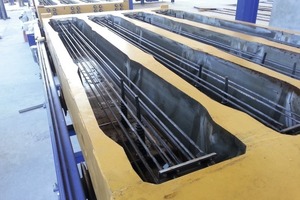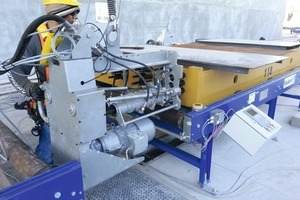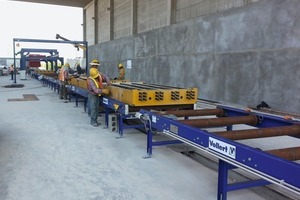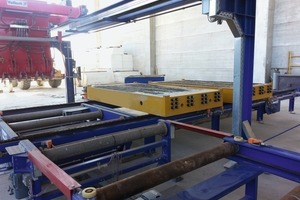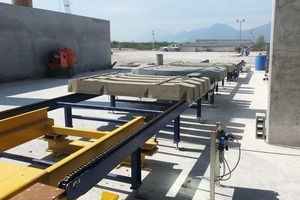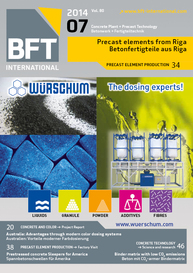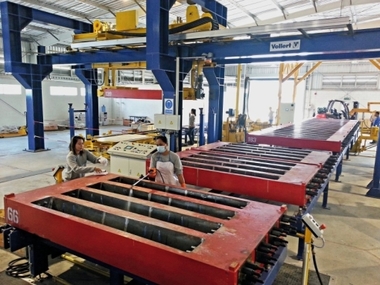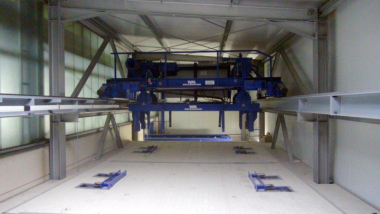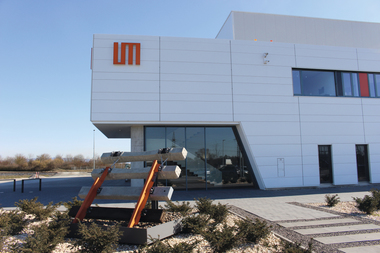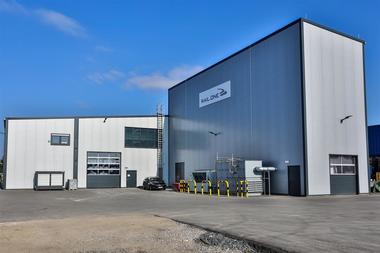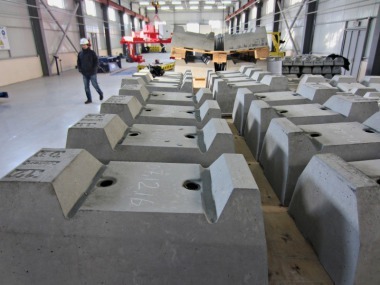Prestressed concrete sleepers for America
Prestressed concrete sleepers for track systems are increasingly replacing steel and wood sleepers. Companies are investing in modern production facilities to meet the demand.
High-speed rail lines traveling at more than 200 km/h and higher axle loads subject the roadbeds of railroad lines to enormous forces. Prestressed concrete sleepers for track systems therefore increasingly replace steel or wood sleepers in rail networks. They have a longer service life, require less maintenance and are more environmentally sound, since impregnation with coal-creosote is eliminated. To meet the rising demand of the industry and the public sector, construction materials suppliers and building contractors increasingly invest in precast plants, as, for example, the GIC Group at its headquarters in the Mexican Monterrey.
GIC Ingeneria y Construcción has been one of the leading construction companies in North America for 30 years. Precast products, such as hollow-core floor slabs, wall elements, columns, and beams for residential and industrial buildings, as well as concrete girders for bridge and road construction have by now been installed in more than 700 construction projects. For further growth, the GIC Group invested in 2013 in a new precast plant for prestressed concrete sleepers. “For the design of the mold circuit, GIC had placed priority on a sustainable plant concept, flexible process flows that provide for subsequent capacity increases, and a high measure of workplace safety. We oriented our focus on these aspects,” says Steffen Schmitt, senior sales manager at Vollert.
350,000 prestressed concrete sleepers annually
The compactly designed production circuit takes up a footprint of only 1,200 m2. Production capacity will be upgraded in several steps to a maximum annual output of 350,000 prestressed concrete sleepers. This would correspond to a two-shift operation and a daily output of more than 1,300 concrete sleepers. 280 sleeper molds are continuously in circulation.
Production of the prestressed concrete sleepers commenced in March 2014. The quadruple sleeper molds are oiled and cleaned before installing the dowels required for subsequent fastening to the rails. Next, prior to casting, the prestressing wires are installed in the mold. A button heading machine connects always four individual wires at a time via two anchor plates to form an assembly part before the anchor plates are affixed to the tightening and anchor bolts already installed in the sleeper mold. In a next step, the wires are prestressed with the tightening bolt, during which process the tightening torque of every prestressing wire is continuously monitored and recorded. The safety mats installed in this work area ensure a high measure of workplace safety. The prestressing process is interrupted and material transport stopped as soon as a worker steps onto these safety mats.
Turning device for transporting and turning
Roller conveyors then transport the preassembled mold to the sound-insulated casting chamber. The semi-automated concrete distributor casts the molds with high precision via electrically driven discharge screws. A high-frequency vibration station ensures uniform concrete compaction. To provide for the intended addition to capacity, a floor space for another compaction station has already been earmarked in this work area. Next, the cast mold is transported by a corner conveyor unit on a chain conveyor to the curing chamber. There, a hall crane with an attached lifting beam picks up the quadruple molds and stacks up to eight molds onto a waiting trolley. The curing chamber is heat-insulated and fitted with a heating device. The rail-mounted trolleys are pushed through the curing chamber at predefined cycle times. A chain pusher advances the complete train of trolleys always by the length of one trolley. In the exit area, after a curing time of around 20 hours, another chain pusher pulls the trolleys one by one out of the curing chamber. On an area of 210 m2, a total of three trolley trains can be accommodated in the curing chamber. All transport and storage processes are controlled via a central computer; the same as the entire plant circulation. Output quantities and plant productivity are constantly evaluated.
Another hall crane in the outfeed area of the curing chamber is fitted with a special lifting beam. “A highlight is here the integrated turning device. The lifting beam is designed for transporting the molds as well as for turning them,” explains senior sales manager Schmitt. The molds are first removed from the discharge trolley and stacked onto a chain conveyor. The tension reversal process is initiated via a semi-automated tension release unit and the prestress released into the concrete sleeper. The turnover beam then turns the mold by 180°, before an electric lifting device removes the sleepers from their mold. The mold is then turned back by 180° and returned to the mold circulation. The prestressed concrete sleepers are delivered ready for laying. For this purpose, the entire reinforcement is installed in the sleepers and prestressed in accordance with the relevant standards. The rail fastenings are completely assembled as well. For this purpose, the sleepers, once removed from their mold, are passed on to the rail assembly station.
Higher plant capacity and workplace safety
“To GIC, Vollert was the right know-how partner for engineering and plant technology. We found the proper balance between the degree of automation and the high output of the plant. In the subsequent expansion steps we can adjust to the aimed-for output quantities without any problem,” says Mauricio Gutiérrez, sales director at GIC.” Safety at work has been given special consideration in every workflow.”
With this investment, GIC has taken an important step into the future. Sales activities on the Mexican market, as well as on the international markets, in particular the US market, can now be pursued with new vigor.

